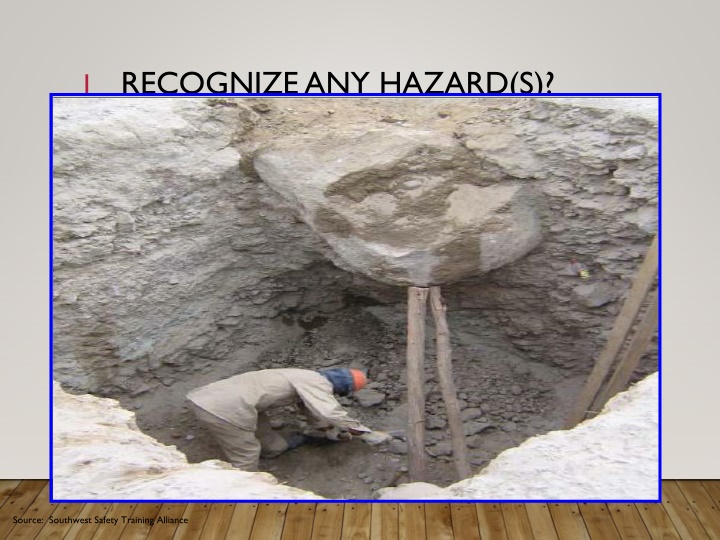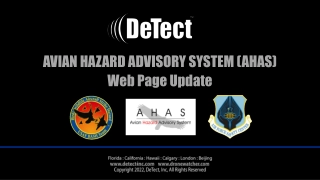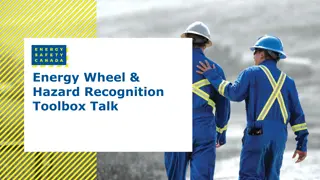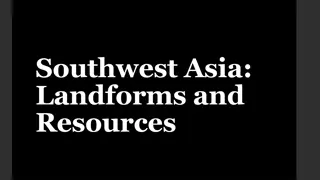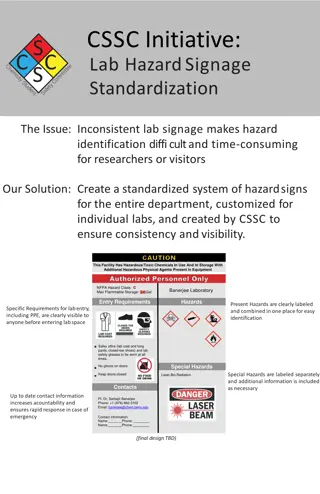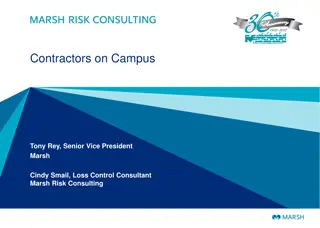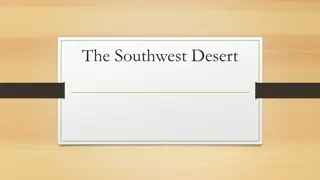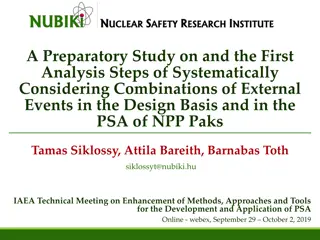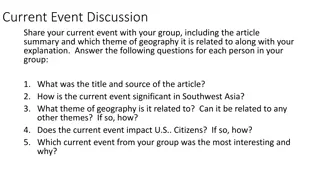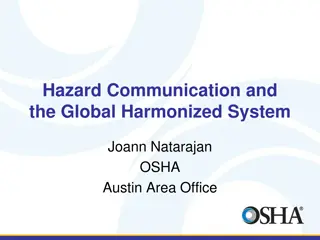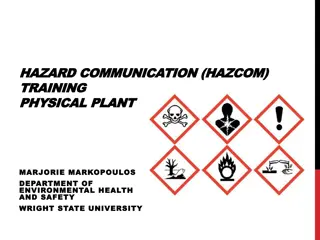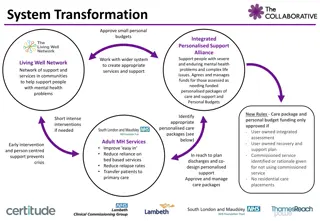Recognize Any Hazard - Southwest Safety Training Alliance
Potential hazards in various workplace scenarios are highlighted, such as crushing hazards from overhead boulders, caught-in hazards, and dangers from unguarded belts and pulleys. Workers are cautioned about risks such as being engulfed by collapsing trenches or working unsafely near dump trucks.
Download Presentation

Please find below an Image/Link to download the presentation.
The content on the website is provided AS IS for your information and personal use only. It may not be sold, licensed, or shared on other websites without obtaining consent from the author.If you encounter any issues during the download, it is possible that the publisher has removed the file from their server.
You are allowed to download the files provided on this website for personal or commercial use, subject to the condition that they are used lawfully. All files are the property of their respective owners.
The content on the website is provided AS IS for your information and personal use only. It may not be sold, licensed, or shared on other websites without obtaining consent from the author.
E N D
Presentation Transcript
RECOGNIZE ANY HAZARD(S)? 1 Source: Southwest Safety Training Alliance
YES 2 No protective system in this excavation. Potential crushing hazard from overhead boulder.
RECOGNIZE ANY HAZARD(S)? 3 Source: Compacion Foundation (HCAdetejas.org)
YES 4 Caught-in hazards occur when a worker could be caught inside of or in between different objects
RECOGNIZE ANY HAZARD(S)? 5 Source: OSHA Region IV National Photo Archive
YES 6 Unguarded belt and pulley. Worker can get hand and/or clothing caught in running nip point
RECOGNIZE ANY HAZARD(S)? 7 Source: Compacion Foundation (HCAdetejas.org)
YES 8 Gloves, long sleeve shirts, jewelry, or loose fitting clothing can be hazardous if caught in moving parts.
RECOGNIZE ANY HAZARD(S)? 9 Source: OSHA Directorate of Construction
YES 10 Next to a residential structure Worker in an unprotected vertical wall trench [pipe work] is exposed to being totally engulfed by the trench if it collapses. No protective systems in use Ladder at the end of the trench
RECOGNIZE ANY HAZARD(S)? 11 Source: Indian River Community (now State) College
YES 12 Truck box not blocked Do not work between the frame and dump box of a dump truck Source: Indian River Community (now State) College
RECOGNIZE ANY HAZARD(S)? 13 Source: Indian River Community (now State) College
YES 14 Employee could be caught between track of dozer and wall
RECOGNIZE ANY HAZARD(S)? 17 Source: Construction Safety Council
YES 18 The wrecking ball is loosely attached to arm; could come loose and strike operator s cab A worker could be caught between the wrecking ball and the dumpster
RECOGNIZE ANY HAZARD(S)? 19 Source: OSHA Region IV National Photo Archive
YES 20 Unstable footing on scaffold by using concrete block
CAUGHT IN OR BETWEEN - TOPICS 21 Identify common caught-in or between hazards Describe types of caught-in or between hazards Protect themselves from caught-in or between hazards Recognize employer requirements to protect workers from caught-in or -between hazards
CAUGHT IN OR BETWEEN 22 The key factor in deciding between a Caught event and a Struck event is whether the impact of the object alone caused the injury. When the impact alone creates the injury, the event should be recorded as Struck. When the injury is created more as a result of crushing injuries between objects, the event should be recorded as Caught.
CAUGHT IN OR BETWEEN EXAMPLES 23 Cave-ins (trenching) Being pulled into or caught in machinery and equipment (this includes strangulation as the result of clothing caught in running machinery and equipment) Being compressed or crushed between rolling, sliding, or shifting objects such as semi-trailers and a dock wall, or between a truck frame and a hydraulic bed that is lowering
CAVE-INS (TRENCHING) 24 An employee and a co-worker were working in a 9-foot deep excavation installing water pipes, when the south side of the excavation caved in on the employee and buried him. The employee was killed.
CAUGHT IN MACHINERY 25 A worker was ripping a 6-inch piece of wood on an unguarded compound miter saw. His left thumb was caught in the saw and amputated.
COMPRESSED OR CRUSHED 26 A worker was operating a road grader when the engine died and the vehicle began to roll toward a small ravine. The employee jumped off the grader but was pulled under the grader as it overturned. He was killed when he was crushed underneath the tires.
WHAT ARE THE COMMON TYPES OF CAUGHT- IN OR -BETWEEN HAZARDS IN CONSTRUCTION? 27 Machinery that has unguarded moving parts causing caught- in or -between incidents Buried in or by Pinned between
MACHINERY THAT HAS UNGUARDED MOVING PARTS CAUSING CAUGHT-IN OR -BETWEEN INCIDENTS 28 Almost all sites use machinery that has moving or rotating parts or that requires maintenance or repair at some point during construction. If machinery is not properly guarded or de-energized during maintenance or repair, injuries from caught-in or between hazards may result, ranging from amputations and fractures to death.
BURIED IN OR BY 29 The major hazard related to buried in or by is cave-ins of unprotected trenches and excavations. Cave-ins crush or suffocate workers. In addition, trenches may contain hazardous atmospheres; workers can drown in water, sewage, or chemicals in the trenches; and if working around underground utilities, workers may also face burns, electrocution or explosions from steam, hot water, gas, or electricity.
PINNED BETWEEN 30 You can be pinned between equipment and a solid object, such as a wall or another piece of equipment; between materials being stacked or stored and a solid object, such as a wall or another piece of equipment; or between shoring and construction materials in a trench. These types of hazards can result in multiple broken bones, asphyxiation, or death.
USE MACHINERY THAT IS PROPERLY GUARDED 31 Never remove a safety guard when a tool is being used. Hazardous moving parts of power tools and equipment need to be safeguarded. For example, belts, gears, shafts, pulleys, sprockets, spindles, drums, fly wheels, chains, or other reciprocating, rotating, or moving parts of equipment must be guarded if such parts are exposed to contact by workers. Be sure to avoid wearing loose clothing or jewelry that can be caught in moving parts.
USE OTHER METHODS TO ENSURE THAT MACHINERY IS SUFFICIENTLY SUPPORTED, SECURED OR OTHERWISE MADE SAFE 32 Make sure that your equipment is de-energized and cannot be started accidentally. Disconnect tools when not in use, before servicing, and when changing accessories such as blades, bits, and cutters. Turn off vehicles before you do maintenance or repair work. If possible, lock out the power source to the equipment. The type of power source may be electric, pneumatic, liquid fuel, hydraulic, or powder- actuated. Lower or block the blades of bulldozers, scrapers, and similar equipment before you make repairs or when the equipment is not in use.
PROTECT YOURSELF FROM BEING PINNED BETWEEN EQUIPMENT, MATERIALS, OR OTHER OBJECTS 33 BE AWARE at all times of the equipment around you and stay a safe distance from it. Never place yourself between moving materials and an immovable structure, vehicle, or stacked materials Make sure that all loads carried by equipment are stable and secured Stay out of the swing radius of cranes and other equipment. Wear a seatbelt, if required, to avoid being thrown from a vehicle and then potentially being crushed by the vehicle if it tips over.
PROTECT YOURSELF ON EXCAVATION SITES 34 Do not work in an unprotected trench that is 5 feet deep or more. The type of protection may be one of the following: Sloping or benching. Sloping is cutting back the sides of the trench to a safe angle so it won t collapse. Benching uses a series of steps that approximate the safe sloping angle. The angle depends on the soil type. Trench box or shield. These do not prevent cave-ins but protect the workers who are in them if a cave-in happens. Shoring. Shoring are wooden structures or mechanical or hydraulic systems that support the sides of an excavation.
PROTECT YOURSELF ON EXCAVATION SITES 35 Enter or exit a trench or excavation only by using a ladder, stairway or properly designed ramp that is placed within the protected area of the trench. Do not work outside of the confines of the protection system!
TRAINING 36 Make sure you have the proper training on the equipment and hazards of your job so that you can do your work safely.
WHAT IS MY EMPLOYER REQUIRED TO DO TO PROTECT WORKERS FROM CAUGHT-IN OR BETWEEN HAZARDS? 37 Provide guards on power tools and other equipment with moving parts. Support, secure or otherwise make safe equipment having parts that workers could be caught between. Take measures to prevent workers from being crushed by heavy equipment that tips over. Take measures to prevent workers from being pinned between equipment and a solid object.
WHAT IS MY EMPLOYER REQUIRED TO DO TO PROTECT WORKERS FROM CAUGHT-IN OR BETWEEN HAZARDS? 38 Provide protection for workers during trenching and excavation work. Provide means to avoid the collapse of structures scaffolds. Provide means to avoid workers being crushed by collapsing walls during demolition or other construction activities. Designate a competent person. Provide training for workers.
